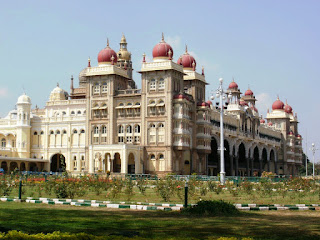The huge cosmopolitan city of Bangalore is home to
some six million people and the hub of India’s booming IT industry.
Fortunately though, in the surge of urban development some care has been taken
to preserve some green space and the city’s colonial heritage. This is
evident in the large Cubbon Park which is home to the attractive red-painted
Gothic style State Library and High Court buildings. Behind the court is
the massive Vidhana Soudha building with the amusing inscription on the front reading
“Government Work is God’s Work”. I’ll let you judge for yourself if this
is true!
 |
| Karnataka State Library, Cubbon Park |
There are a few interesting museums in the city and
I visited a couple of them. The first was an Industrial and Technical
Museum that was totally interactive. So, it was time to release the child
within and play with a large number of scientific exhibits. There was an
interesting display on the Wright Brothers and a replica of their plane the
Kitty Hawk. In their research on the first ever flight there is no mention
of a New Zealander by the name of Richard Pearce though.
It’s been a big day today with a lot of
walking. The highlight was roaming through the huge Lalbagh Botanical
Gardens that sprawl over an area of 96 acres. That’s a lot of garden to
maintain but it’s being done well and with an unusual absence of litter it’s a
very pleasant place to visit. The serenity here contrasted to the hectic
pace of the City Market that I visited earlier. I’m sure in its day it
was more impressive but the small and rather ordinary Tipu Sultan’s Palace
wasn’t worth the cost of admission. The ornate temple adjacent to it was
equally interesting and completely free.
 |
| Vidhana Soudha |
I visited a couple of other temples today where,
being a Sunday, worshippers were out in force. Strangely though, the
cathedral was deserted and not even open. So I went to the nearby cricket
stadium and was met at the gate by two security guards who took their roles
seriously. They reluctantly let me take a photo from the gate and watched
my every move. I wonder what on earth they thought I was going to
do! I finished my day at the Government Museum and adjoining art gallery
that had displays featuring ceramics, sculptures, paintings and a large model
of the original city fort.
So that’s it. I’m not really sure how I’ve
done it but I’ve managed to get though 24 days without the hint of the stomach
problems that plagued my last trip through the subcontinent. I lost 14kg
on that particular adventure so I can only hope that things continue to go well
for the next few weeks!
 |
| Lalbagh Botanical Gardens |
My good health has contributed to a very enjoyable
time here. It’s been a great journey and included so many sights, sounds,
smells, tastes and wonderful people. It really is an extraordinary
country that creates such enduring memories for all who come here. While
walking around on my very first day in Chennai I passed a busload of Korean
tourists. The words “Incredible India” were on the side of their
bus. I was reflecting on that last night and realised how true it
is.
But I couldn’t help wondering how ‘incredible’ it
is being shuttled around in an air conditioned bus and staying in luxury hotels
along the way. Part of what makes India incredible is getting to the
grassroots of the country through talking to the local people and understanding
their culture. Travelling on a budget naturally creates those
opportunities and although there are discomforts involved, being insulated from
them somehow wouldn’t be a complete experience.
 |
| Words of wisdom on the Bangalore streets |
Apart from all the wonderful sights I’ve seen,
simple things that happen every day are what has made India incredible.
Getting sweaty and dusty walking traffic choked streets. Haggling over
the price of a rickshaw ride. Dropping a couple of coins in the dirty
hand of a beggar while waiting for a hopelessly overcrowded bus. Asking
directions from someone who speaks so quickly all you can do is nod, smile and
say thanks. Talking with young men who love cricket and girls that love
men who love cricket. Eating a meal and finding out just how relative the
word ‘spicy’ is.
These are just a few of the things that make India
what it is and I’m fortunate to have been given the opportunity to experience
it again. I can only trust now that Sri Lanka offers something
similar...











